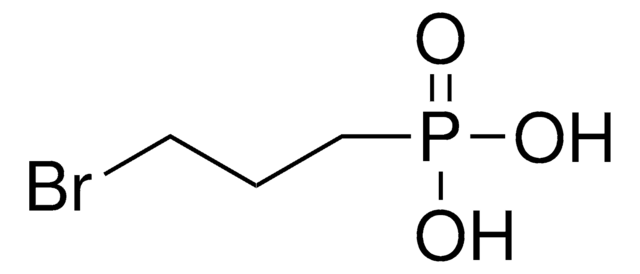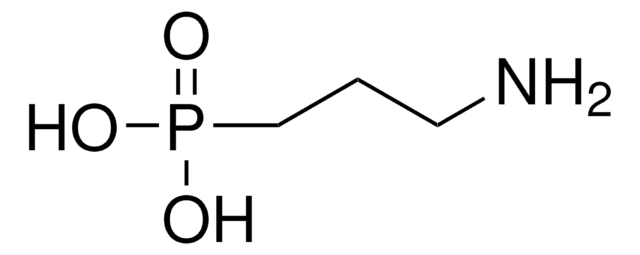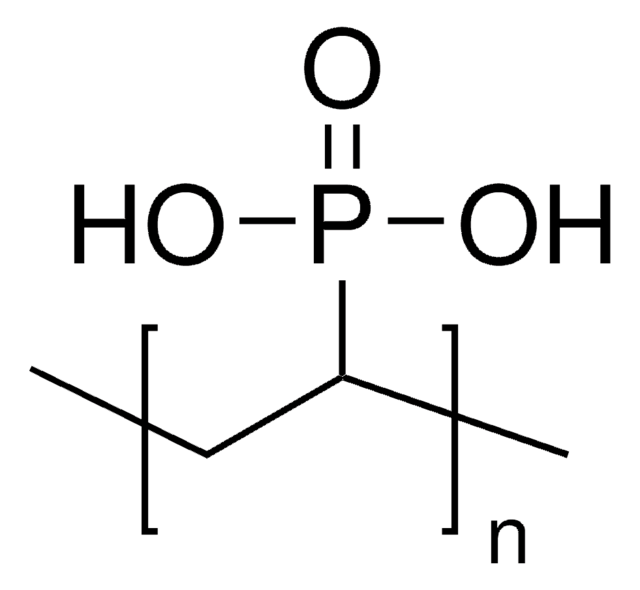745855
12-Mercaptododecylphosphonic acid
95%
Synonym(s):
P-(12-Mercaptododecyl)phosphonic acid
Sign Into View Organizational & Contract Pricing
All Photos(3)
About This Item
Empirical Formula (Hill Notation):
C12H27O3PS
CAS Number:
Molecular Weight:
282.38
MDL number:
UNSPSC Code:
12352103
PubChem Substance ID:
NACRES:
NA.23
Recommended Products
Quality Level
Assay
95%
form
powder
mp
92-96 °C
storage temp.
2-8°C
SMILES string
OP(O)(CCCCCCCCCCCCS)=O
InChI
1S/C12H27O3PS/c13-16(14,15)11-9-7-5-3-1-2-4-6-8-10-12-17/h17H,1-12H2,(H2,13,14,15)
InChI key
PVIUMTORLYKRJT-UHFFFAOYSA-N
General description
12-Mercaptododecylphosphonic acid (MDPA) is an organophosphonic acid that forms a self-assembled monolayer (SAM). The phosphonic groups tend to react with the metal surfaces that allow the formation of metal-oxygen-phosphonate (M-O-P) bonds that facilitate the surface with mechanical and chemical stability.
Application
MDPA based SAM can be coated on TiO2 for potential applications in the extraction of heavy metals. It can also be used in surface modification of a graphene oxide (GO) based active material for the fabrication of a organic field effect transistor (OFET).
Organophosphonic acid self-assembled monolayers (SAMs) for nanoelectronics; solid-state lighting; energy generation and nanocomposites. A mercaptoalkylphosphonate monolayer used to bind gold nanoparticles.
Signal Word
Warning
Hazard Statements
Precautionary Statements
Hazard Classifications
Eye Irrit. 2 - Skin Irrit. 2 - STOT SE 3
Target Organs
Respiratory system
Storage Class Code
11 - Combustible Solids
WGK
WGK 3
Choose from one of the most recent versions:
Already Own This Product?
Find documentation for the products that you have recently purchased in the Document Library.
Customers Also Viewed
Peter J O'Brien et al.
Nature materials, 12(2), 118-122 (2012-11-20)
Manipulating interfacial thermal transport is important for many technologies including nanoelectronics, solid-state lighting, energy generation and nanocomposites. Here, we demonstrate the use of a strongly bonding organic nanomolecular monolayer (NML) at model metal/dielectric interfaces to obtain up to a fourfold
Self-Assembled Monolayers of 12-Mercaptododecylphosphonic Acid on Titania Particles; Application to the Extraction of Heavy Metals
Antherieu S, et al.
MRS Online Proceedings Library, 847(1), 141-149 (2004)
Driving forces for the self-assembly of graphene oxide on organic monolayers
Kirschner J, et al.
Nanoscale, 6(19), 11344-11350 (2014)
Phosphonate monolayers functionalized by silver thiolate species as antibacterial nanocoatings on titanium and stainless steel
Amalric J, et al.
Journal of Materials Chemistry, 19(1), 141-149 (2009)
Randall M Stoltenberg et al.
Langmuir : the ACS journal of surfaces and colloids, 27(1), 445-451 (2010-12-08)
Developing orthogonal surface chemistry techniques that perform at the nanoscale is key to achieving precise control over molecular patterning on surfaces. We report the formation and selective functionalization of alumina nanoparticle arrays generated from block copolymer templates. This new material
Our team of scientists has experience in all areas of research including Life Science, Material Science, Chemical Synthesis, Chromatography, Analytical and many others.
Contact Technical Service










